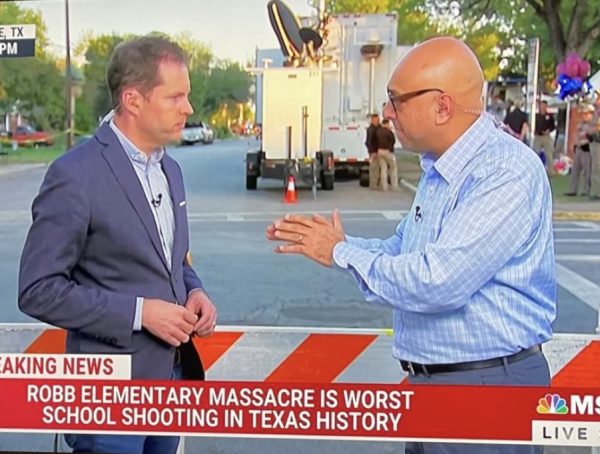Dana Robertson is a former CBS producer who worked for CBS News 60 minutes. While meeting journalism students at the University of Mississippi, Robertson explained different steps of producing an investigative story through the example of one of her biggest stories – exposing the abuse of Iraqi prisoners by the U.S. military.
“I’ve done a little bit of everything but I will say my passion is investigative journalism. I love it, it’s hard, it’s scary, which is probably why I love it so much because I like to challenge myself. There is that not much of it anymore, unfortunately, it’s time-consuming it’s expensive, it can be dangerous…”
1. Find the story
One of the key rules in journalism is to always keep in contact with sources. Robertson insists on how important that principle is since it is what led her to the story.
“Always hold on to your contacts, keep in touch with people, follow up with them, talk to as many people as you can, and just be consistent throughout your career. I still reach out to people who gave me information decades ago. I may never do a story again on any of these things,” Robertson says.
She had worked on a previous CBS story called “Apache Down,” and remained in contact with several sources. One day in April 2004, she received a phone call from the communications person from the Apache Down story, telling her he has a story for her. The source was calling from Bagdad, Iraq, and heard during a press briefing that occurred in January 2004 that there was an ongoing inside investigation about the misbehavior of military personnel in the Abu Ghraib prison (Iraq). The topic was only mentioned quickly, without getting into details. Robertson’s contact then proceeded to inform her military police and American soldiers had taken pictures abusing Iraqi detainees, smiling and posing next to the POWs (prisoners of war). Her contact had seen the pictures, he could describe them, but he did not have them in his possession.
2. Find leads and contact people
Robertson’s contact gave her a name, Joe Darby, who had initially found the pictures. He was a military officer who asked his colleagues for pictures they took during their time in Bagdad since he did not take any. He was given a CD containing pictures of the scenery, but at the end of the CD were the controversial pictures. Offended by them, Darby turned the CD to a commanding officer, without anyone knowing he was the leak.
At this stage, Robertson kept on digging and used “Lexis Nexis” database for public and private information on the unit at the center of the controversy. There was no communication with the military at this stage of the investigation.
“I’m just trying to track down, I’m really trying to get the photographs, I’m really trying to verify that the story is real,” says Robertson.
Finally, she and her team manage to find the same of someone part of that unit and who allegedly appeared on the pictures, named Chip Federick. They got in contact with his attorney, Gary Myers, who informed them the soldiers had been coerced by higher-ups to mistreat the prisoners. However, he had not seen the photographs himself.
3. Build evidence
Despite Frederick being in Iraq, the team manages to have a conversation on the phone with him on the record, which ended up being key evidence in the investigation. Frederick did act under the belief that higher-ups were wanting him to humiliate the prisoners. He then refers them to Lieutenant Colonel Bill Cowen who confirms the story and provides more information and documents to Robertson’s team… but not the photographs.
Robertson, therefore, continues to search for the photos. She flies — while being pregnant — to Kuwait, at the border with Iraq, and meets some sources there but she still does not manage to get a hand on the controversial pictures.
This is where Robertson’s 3 qualities every investigative journalist must have become essential: “tenacity, reluctance, and persistence.”
A couple of days after coming home, she receives the photographs at her desk from an email address ending in .mil signifying a military address, but without any identifiable name. There were about a dozen photographs, shocking images including nudity and abuse.
4. Verify and fact-check
The team proceeded to reach out to the Pentagon, judging they had enough proof to demand comments from higher authorities. The Pentagon did confirm the existence of the pictures as well as their knowledge of the pictures existing.
“That’s the verification process. When you get photographs, especially now, you’re [wondering] ‘Are these the real thing?’ These are so outrageous, can someone really just be trying to put these out there and get us to broadcast them and they’re not real… But we had verification: we had my first initial contact who described them to me, we had eventually Gary Myers and Chief Frederick talked about the photos, we knew yes he posed in the pictures, yes that’s him in the pictures; we have the Pentagon basically saying they know of the existence of these pictures,” Robertson continues.
This step is essential, especially in investigative journalism. Whether you are attacking a private persona or a national organization, you have to be absolutely sure of your reporting.
“Make sure everything is verified and done within the rules because people will try to take you down,” says Robertson.
5. Release the story
The last step for Robertson and her team was to break the story. They started by informing the Pentagon that they would publish the pictures and air the story. This led Chief of Military Staff Richard Myers to call her in the middle of the night to try to avoid having the pictures published. According to him, it would endanger the lives of soldiers still overseas, especially since one soldier had gone missing, and releasing this story could cost him his life if the story breaks out and reaches Iraq.
Dan Rather, Robertson’s colleague, answered that they agreed to hold the story for a week if the Pentagon granted them an interview with someone high up. But two weeks went by and the Pentagon kept on delaying. Around that time, another reporter heard about the story and was planning on airing it, therefore they had no choice but to decide to air the segment.
“Next day we get General Mark Kimmit, literally the day before we were going to air, it might even have been the morning of air, it was a crash edit to drop him in,” Robertson remembers.
The story finally aired and made a lot of noise. Overall, it revealed a bigger picture than American soldiers abusing POWs, it revealed a lack of training regarding Geneva Convention rules as well as leadership issues among the ranks.
Unfortunately, the story also caused most of her team to have to step down because they did not follow the rules as well as they should, while Robertson, on her side, was on maternity leave.
“This is actually a cautionary tale … When you’re doing an investigative story, everyone is looking or coming at you. For everything. They are looking for any tiny slip-up that you have. There was a slip-up, and people found it and that team had to step down from the anchor chair,” Robertson says.
Despite the hardships of the position, Robertson admits she loved being an investigative journalist. There is not much of it anymore, unfortunately, she says, since it is time-consuming, expensive, and can be dangerous. But these flaws are, according to her, what also makes the job great.
“I’ve done a little bit of everything but I will say my passion is investigative journalism. I love it, it’s hard, it’s scary, which is probably why I love it so much because I like to challenge myself,” says Robertson.








